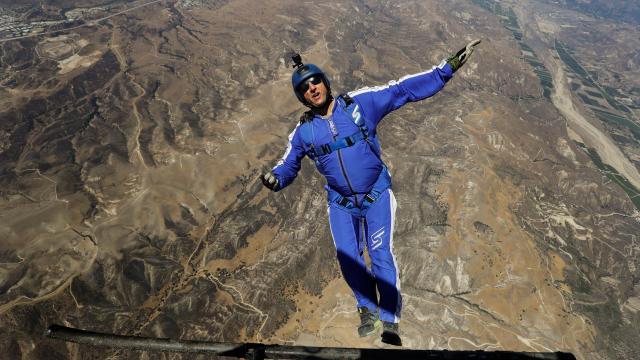Skydiving is pretty terrifying on its own, even when you take into account necessary safety precautions. But what if you were to jump from an aeroplane without a parachute? If Luke Aikins’ stunt is any indication, you’d have to be highly skilled and train for two years before even attempting it. There’s also the issue of jumping from an plane without a parachute.
On Saturday, Aikins successfully fell 7,620.00m from a plane with nothing on him but a GPS, a camera, a communication device, and an oxygen mask, which was removed and handed to one of the three parachuted assistants at around 5,486.40m. Without a wingsuit or a parachute, he landed just a couple minutes later safely on a 1,000-square-foot net.
The fall itself is pretty amazing. It was broadcast on television (claiming to be live but on a one-hour delay), so you can watch it below in case you missed it.
“I’m almost levitating — it’s incredible, this thing that just happened,” he told reporters after climbing out of the net, according to E! Online. “The words I want to say, I can’t even get out of my mouth.”
Obviously, this isn’t something that anybody should be attempting. Aikins, who was the skydiving consultant on Felix Baumgartner’s famous supersonic freefall in 2012, has skydived around 18,000 times in his decades-long career. The 42-year-old has been training for two years to get to this point, and that was after some trepidation.
“Like any normal, sane person, I said: ‘Thank you, but no thank you. I have a wife and a son, and I’ve got a life to live,’” he said to People Magazine. “Then, two weeks went by and I kept waking up in the middle of the night thinking, ‘If somebody said you had to do this, how could it be done?’”
So how was it done? Aikins used the GPS and four lights on the net to square up the landing. The net was specifically made to decelerate his fall as he landed on it. According to National Geographic:
“The netting itself is constructed from Spectra, a high-density polyethylene cord that is twice as strong as steel, but also completely inelastic. Once Aikins’ plummeting mass strikes the net, four compressed air cylinders, which are connected to the netting via ropes and pulleys, will slow Aikins down down in the same way that you might catch an egg in your hand — by decelerating it gently over a distance.”
Other precautions were taken into account for the fall. Since oxygen levels become lower the higher you get, an oxygen mask aided Aikins for the first segment. Aikins is also a professional skydiver, which means that he knows how to fall. According to Popular Mechanics, the way skydivers fall — arms and legs spread, with your chest facing the ground — is a way to slow your descent by adding friction. It also helps people to manoeuvre the fall.
However, the hero of this fall — and other falls like it — is terminal velocity, which means that eventually, thanks to gravity pulling an object towards the ground and drag, Aikins stopped accelerating after a certain point.
So while it seems crazy, it’s not implausible. There’s been around 13 plausible freefall incidents since the 1940s where people have survived long falls, such as the story of a World War II pilot that fell 6,096.00m from his B-17 and crashed into a train station, the debris helping to cushion the blow.
